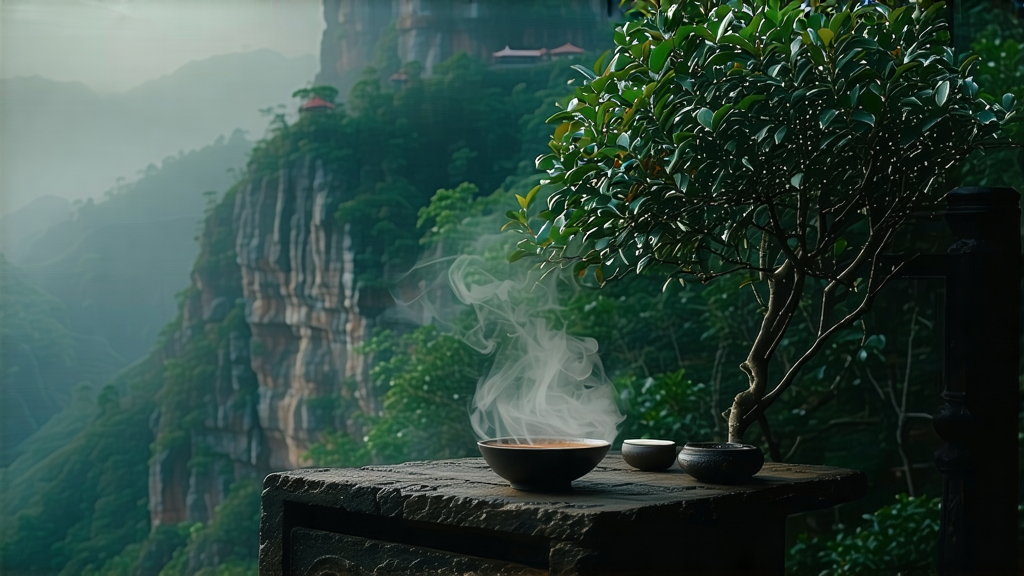
When Chinese tea lovers speak of “rock rhyme”—the mineral whisper that lingers after swallowing an oolong—they are almost always talking about Da Hong Pao, the legendary Scarlet Robe grown on the sheer cliffs of northern Fujian’s Wuyi Mountains. Few teas carry as much romance, imperial folklore, and sensory complexity in every leaf. To understand Da Hong Pao is to step into a thousand-year dialogue between monks, merchants, poets, and emperors, all of whom found something transcendent in a cup that tastes of mist, pine smoke, and liquid stone.
Historical legend places the birth of Da Hong Pao during the Ming dynasty. A scholarly candidate on his way to the capital fell gravely ill at the foot of the Wuyi cliffs. Monks from the nearby Tianxin Temple brewed leaves plucked from six bushy old trees growing out of a narrow rock crevice; the scholar revived, continued his journey, and placed first in the imperial examinations. To express gratitude, he returned in crimson official robes and draped them over the bushes, proclaiming their life-saving virtue. The name “Big Red Robe” stuck, and imperial tribute lists soon required the tiny yield of those mother trees. For centuries only a handful of leaves were harvested each spring; the Qianlong Emperor himself is said to have guarded the secret recipe. Today the original six bushes still cling to Jiulongke, their gnarled trunks cosseted by a small pavilion and armed guards, but almost every sip of modern Da Hong Pao comes from genetically verified cuttings propagated since the 1980s, ensuring both conservation and accessibility.
Botanically, Da Hong Pao belongs to the Wuyi rock oolong family collectively called yancha. Within that family it is not a single cultivar but a stylistic benchmark built around three historically celebrated bushes: Qi Dan, Bei Dou, and Que She. Commercial grades now fall along a spectrum. “Mother Tree Da Hong Pao” refers to the pre-2006 harvests that ceased when the originals were retired; a mere 20 g of that tea once sold for over USD 30,000 at auction. “Pure Da Hong Pao” is crafted from one of the direct clonal lines, prized for genetic fidelity to the original mineral bite. Most common is “blended Da Hong Pao,” an artful marriage of several Wuyi cultivars—Rou Gui for spice, Shui Xian for orchid depth, Tie Luo Han for structure—orchestrated by a master blender to recreate the archetypal rock rhyme. Each style offers a different lens on the same cliff-lined terror.
The Wuyi Mountains form a 650-meter-deep river gorge where morning fog traps moisture and afternoon sun refracts off mineral-rich granite. Tea gardens are literally vertical; bushes root in narrow ledges, forcing roots to struggle and concentrate flavor. The microclimate gifts the leaves an unusually high ratio of polyphenols, amino acids, and aromatic volatiles, but it also demands perilous picking. Experienced pluckers work from bamboo scaffolding tied to iron stakes, harvesting only the middle three leaves and the tender bud in late April when the leaf’s edge turns slightly golden. A 30-year veteran can finish barely four kilograms of fresh leaves in a day, the first reminder that great Da Hong Pao is born of patience and risk.
Once carried down the cliff in wicker backpacks, the leaves undergo one of oolong’s most intricate transformations. Withering starts outdoors on bamboo screens rocked gently by hand every ten minutes; cool gorge breezes reduce moisture to 70 % while initiating enzymatic oxidation. The real drama begins indoors: leaves are tumble-tossed in a heated bamboo drum at 220 °C for seconds, just enough to bruise cell walls without crushing them. This alternating bruise-and-rest cycle, repeated six to eight times through the night, edges oxidation to 40–50 %, the sweet spot where green floral notes meet burgundy malt. At dawn the master judges readiness by the sound of rustling leaves—an audible crackle like distant fire—and the appearance of a crimson fringe around each green leaf, the “red edge green center” hallmark of premium yancha.
Charcoal roasting follows, the step that stamps Da Hong Pao with its signature campfire warmth. Traditionally, leaves are loaded into 50 g rattan baskets and placed over a pit of glowing lychee-wood embers that hold a steady 80 °